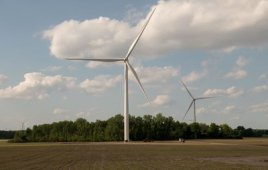Bob Drexel/Vibration Product Manager/ifm efector/Exton, Penn./ifm.com/us
An early failure indicator in wind-turbine equipment is a change in its vibration level. On a typical wind turbine, bearing failure and gearbox damage are major causes of turbine downtime. Key to detecting potential failure of wind turbine equipment before it happens is a continuous monitoring of vibration levels of rotors, gearboxes, and generators. Condition-based monitoring (CBM) for wind turbines traditionally includes gathering large amounts of spectrum data, storing the data, and analyzing it off-line. This type was effective for traditional power generation which relied on a few large turbines that required a few measurement points for their kilowatt output.
However, adapting traditional CBM systems to today’s larger distributed base of wind turbines with thousands of measurement points diminishes the cost effectiveness and adds additional system and organization complexity.
By applying the latest cost-effective technologies such as MEMS accelerometers and low-cost digital signal converters with Ethernet communication, wind-farm operators can deploy CBM systems without a high level of vibration analysis knowledge. In addition, these technologies let wind-turbine operators self-deploy an effective CBM system without the associated high costs.
Real world example
Based on extended monitoring and testing of 1.5 MW wind turbines, operators can learn to effectively monitor a turbine’s rotating equipment. The process breaks into four action points: identify accelerometer locations inside the turbine, determine a monitoring method appropriate for each location, analyze the data, and communicate the data collection.
Today’s accelerometers are extremely compact which allows easily mounting them near rotating components such as bearings and gears. Typical installation is by glue on mounting bases that require no modifications to turbine components. The illustration Inside the nacelle depicts a typical wind turbine and identifies accelerometer locations which are strategically located to monitor all rotating components.
Monitoring the essential points on a wind turbine takes eight accelerometers. Choose locations close to the intended target of the monitoring point and mount the accelerometers on rigid structures so as not to influence vibration readings due to flexing in the mounting surface.
Determine the monitoring method
Several monitoring methods can be applied depending on the type of mechanical component. Rotating components, such as bearings, gears, and shafts, require different monitoring techniques. These are grouped in three categories:
Fast Fourier Transformation (FFT), the backbone of vibration monitoring, converts the overall measured vibration into its specific frequencies and vibration level.
Hanning Fast Fourier Transformation (H-FFT) creates an “enveloping” of the target frequency and is typically used for monitoring rolling element bearings.
Broad or Band Monitoring checks the vibration level of a complete system (or portions of complete systems). Typically, machines produce repeatable vibration “finger prints”. A change to the broadband vibration level signifies some type of anomaly that can be used as a general indicator of changing conditions.
Bearing signals from H-FFT
Bearings fail from overload, misalignment, insufficient lubrication, and assembly defects. Bearings are typically monitored at specific small-band damage frequencies according to the geometry of their inner race, outer race, and rolling elements using an enveloped spectrum (H-FFT analysis). Upward changes in the vibration level on these signify mechanical issues with the bearings. For example, it detects issues such as lack of lubrication or pitting. The trend history charts above show evidence of bearing wear detected through H-FFT analysis on wind turbines.
Gear wear and FFT
FFT analysis can detect gear wear issues such as misalignment, cracked or broken teeth, and excessive lash. Using the rotational speed and the gear ratio, a gear-mesh frequency can be calculated with an FFT analysis. To monitor gears, the method creates a narrow band FFT monitoring the mesh frequency and adjacent frequencies called side bands. These three narrow FFT bands plus the second and third harmonics of the mesh frequency and harmonics are evaluated to detect gear wear and defects.
Band-frequency monitoring
Band monitoring can detect many different mechanical issues such as broken or loose rotor bars. One typical broadband method monitors a frequency range of 10 to 1,000 Hz. Capturing the rms (root mean square) average for such bands is useful for general mechanical problems.
The table provides a comprehensive list of components that can be monitored on a typical turbine and their respective monitoring methods.
Signaling alarms and storing data is a final step. The best way to do so depends on the infrastructure of the wind farm and its systems. Approaches fall into three categories:
Digital I/O to turbine controller
Warnings and alarms can be configured to provide digital feedback when any of the monitored parameters exceed their allowed limits. Tying into an existing control system is an inexpensive option but may not provide enough detailed information regarding which object caused the alarm and the reason for it.
Data acquisition by Ethernet
Integrating the vibration monitoring system with the wind farm’s Ethernet network allows remotely accessing monitoring systems for evaluation of current vibration levels as well as viewing and collecting trend history data. This can be accomplished through a wired or wireless network. If networking is not possible, a simple low-cost industrial PC with memory card can be located at the tower base making data collection easier.
Data collection by SCADA
These Supervisory Control and Data Acquisition systems can extract valuable spectral and historical information from vibration monitors and manipulate the data as needed. Many systems communicate through an OPC (Open Packaging Conventions) client-server relationship. Monitoring systems can be polled on a regular basis and results used to trend the condition of the wind turbines.
This allows evaluating all monitored parameters in real time. Historical data can be stored for later analysis as required.
Applying an intelligent vibration monitoring system in four steps lets wind farm operators implement a predictive-maintenance system. With today’s lower-cost innovations, these once highly expensive systems now allow for large fleet implementation at affordable costs.
Filed Under: Uncategorized







